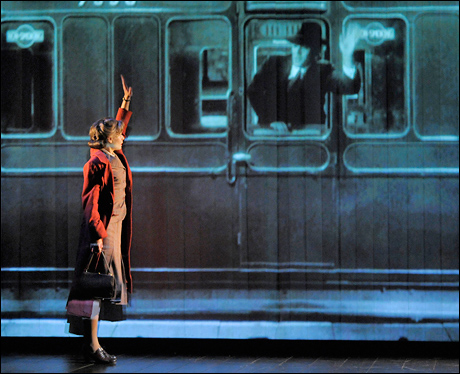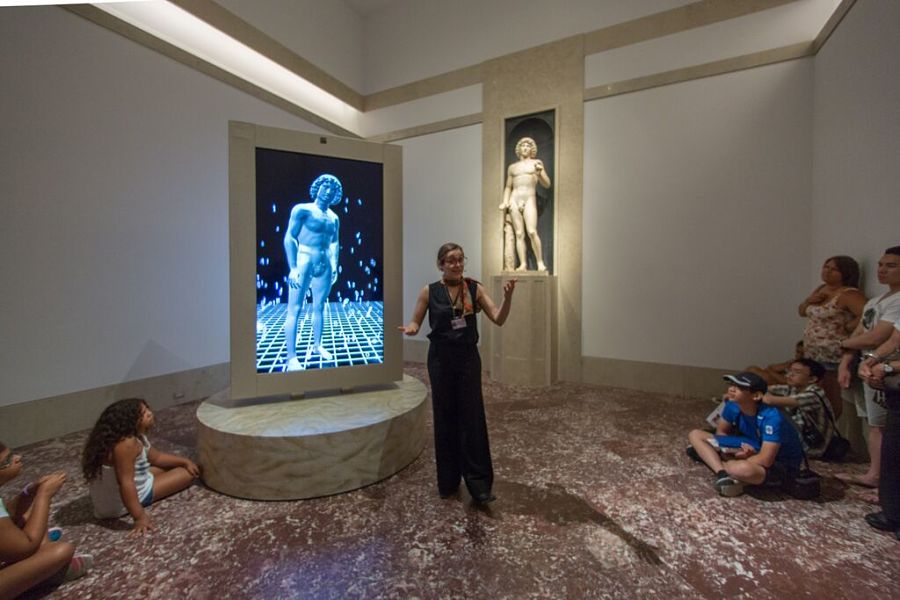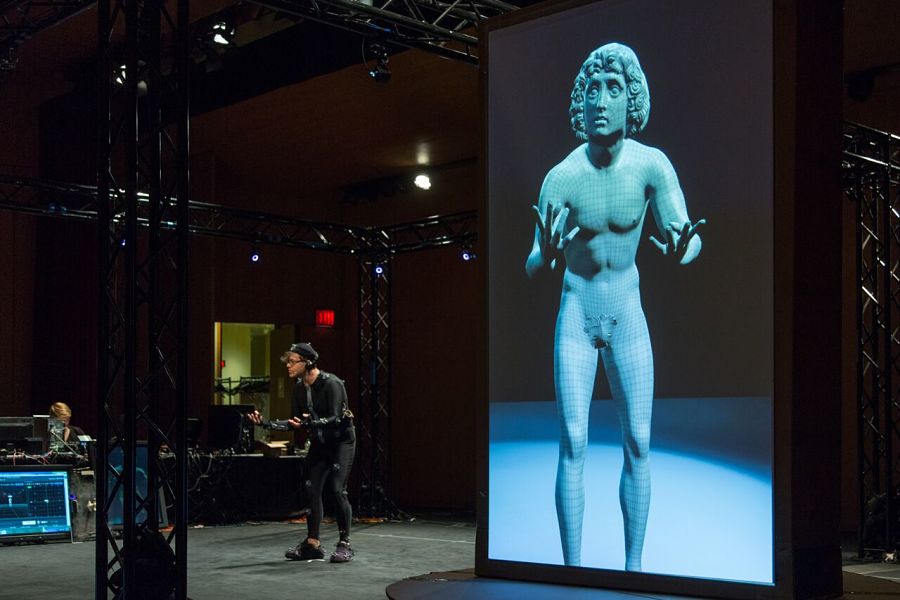Lisa Ryder has acted on screen, and she has acted onstage, but never before has she acted onstage and onscreen at the same time. “It’s very, very tricky,” she says with a laugh. “It’s the weirdest thing; it’s hard to describe.”
Ryder portrays the title character of Helen Lawrence, a work from the Toronto-based Canadian Stage that has been touring North America and Europe since 2014 and will stop at the Brooklyn Academy of Music Oct. 14–17. Ryder and the other live cast members perform onstage while their images simultaneously appear much enlarged on a screen. Even the person who conceived and directed Helen Lawrence has problems describing it. “It’s not the same as theatre; it’s not the same as film. It’s a third thing,” says director Stan Douglas. “For now, I’m calling it live cinema.”
Director Reid Farrington is not searching for a new name for what he does. “It’s certainly new, and it’s incredibly hard to do, but I’ve never thought of it as anything but theatre,” said Farrington. His latest piece, The Return, was presented this past summer at the Metropolitan Museum of Art. In a man-sized video monitor, placed into a gallery of the museum, a cartoon-like image of Adam, the first man, talked to museumgoers about a few falls he took (both mythical and literal). Simultaneously, in an auditorium in another part of the museum, visitors could watch how this cartoon Adam was being made to move and talk, as a live actor stood on a stage generating “Digital Adam’s” speech and movement.
Both Helen Lawrence and The Return are experiments in a pioneering theatrical genre, or perhaps subgenre: the effort to integrate live filmed images into live theatrical performance. Whatever the genre is called, Douglas believes it “has great potential for storytelling.”
“It’s an exciting time for this kind of technology,” says Farrington, who thinks of it as “the natural evolution of the traditional theatrical tools like lighting, sound, and video design.”
The Next Step in Projection Design
The mixing of projected video with live actors has a relatively long history, and it has stepped up in popularity over the last few years. Wendall K. Harrington was credited as a “multi-image producer” for They’re Playing Our Song in 1979, the first of 37 Broadway productions for which she has served as (what has come to be called) projection designer. Five years ago, Harrington launched a new concentration in projection design at the Yale School of Drama, and in 2013, the New York–based Drama Desk Awards added Outstanding Projection Design as a new awards category.
The first winner was Peter Nigrini for Here Lies Love, the Off-Broadway musical about Imelda Marcos by David Byrne and Fatboy Slim, which recreated the feel of a 1970s-era discotheque. The show also used live video feeds, as a reporter with a video camera interviewed Ferdinand Marcos and the video was being shown instantaneously on monitors, as if being broadcast on television. Director Alex Timbers used the same approach (with video designers Dan Scully and Pablo N. Molina) to recreate the feel of an important televised event in the 2014 Broadway production of Rocky.

In Emma Rice’s stage adaptation of the 1945 David Lean movie Brief Encounter, live actors seemed to literally step into and out of a black-and-white film; in one moment, actress Hannah Yelland exited via a white curtain in the middle of the stage, where film was being projected, after which her character appeared onscreen. The currently running Curious Incident of the Dog in the Night-Time uses elaborate imagery—rapidly changing geometric patterns, words, and numbers—to suggest the way the world is perceived by the main character Christopher, a teenage math savant on the autism spectrum. The show includes such coups de théâtre as Christopher literally climbing the wall—a projection of an escalator appears onstage, on which he then descends.
But to Kevin Cunningham, the greatest innovation lies outside of mainstream theatre, among troupes like the Builders Association or the Wooster Group (for whom Farrington has designed projections), which have long explored the interaction of media and live performance.
“In my opinion, most so-called ‘projection design’ for the theatre misses the opportunities provided by digital technology for the stage,” he says. Cunningham is the artistic director of the theatre company 3 Legged Dog, which since 2006 has run the performance venue 3LD Art & Technology Center in lower Manhattan, an incubator for the kind of work that Farrington is pioneering.
Indeed, last year, 3LD served as home for Farrington’s Tyson vs. Ali, an imagined boxing match that used two live actors as the champs, but also life-sized video projections of actual fights cleverly incorporated into the ring so that the live actors appeared to be fighting with the title heavyweights. Though Farrington calls himself a theatre director, he adds, “I’ve never done anything unplugged.”
The First Man, Restored and Digital
The development of Farrington’s The Return, commissioned by the Met, came about in the aftermath of a catastrophe. Tullio Lombardo’s Renaissance sculpture of Adam, made in Carrara marble in the 15th century, crashed to the ground in 2002 when its pedestal at the Met inexplicably buckled; the masterpiece shattered into 28 major fragments and hundreds of smaller pieces.
The museum’s conservators developed a computer model to help figure out how to put the statue back together without having to touch the fragments and thus risk further damage. It took 12 years, but the marble statue is once again beautifully intact. It stands perched on a new pedestal against the wall of the Met’s Venetian sculpture gallery. This past summer, a six-foot-high video screen in the center of the small gallery showed “Digital Adam,” who resembled the computer model used to help reassemble the statue.
“The right leg broke off here and here,” Digital Adam said, pointing to two areas of his leg that then lit up. “The left leg broke into six fragments, here, here, here, here, here, and here,” and each lit up in turn. Over the course of the scripted presentation (written by Sara Farrington, the director’s wife), Digital Adam became Biblical Adam, who looked the same as Digital Adam except that he had darker skin and was standing waist-high in the green grass of Eden. Then Biblical Adam turned into Tullio’s Adam, whose coloring and texture more closely resemble the marble statue.

Occasionally, God made an appearance—a close-up of Adam’s face, blindingly lit—and, at one point, so did a certain serpent. The virtual characters talked with a flesh-and-blood docent, played by an actor, standing in the gallery; the two conversed about art history, biblical stories, the history of humanism, and the process of art restoration. They even cracked some jokes.
Every now and then, one of the onscreen characters peered through the screen as if through a window, addressing individual audience members standing in the gallery and remarking on what they were wearing or asking them what scene they wanted next.
The Return used the sort of motion-capture technology that created the lifelike creatures in such films as Avatar and Planet of the Apes. In those movies, actors playing Na’vi or apes wore special suits full of sensors that captured their precise movements onto a computer—movements that were then turned into on-screen animations by designers and animators over the course of hundreds of hours.
An actor gives life to a digital recreation of Tullio Lombardo’s Adam sculpture at the Metropolitan Museum of Art. (Photo by Thomas B. Ling)
New technology has compressed that time horizon. “What’s cool is that we’re now able to achieve the same results live that once took days or weeks to achieve,” says Athomas Goldberg, who designed the digital puppetry of The Return. Goldberg, originally a theatrical set and lighting designer, spent 20 years as an animation director and technologist in the video game industry. Last year he left video games and went back to live performance, but he didn’t abandon what he’d learned in the previous two decades, using motion-capture technology for several dance pieces before employing it for The Return.
As in the movies, an actor (Jack Frederick, Roger Casey, or Gavin Price, who worked in shifts) donned a black plastic motion capture suit with 49 sensors attached and wore a helmet with an attached microphone. An unobtrusive camera in the gallery allowed the actor to see what was going on there, which is how the digital puppet was able to interact with the docent and the audience.
There were two ways that the motion capture in The Return differed from its use in Hollywood. First, the animation looked less life-like by comparison; Adam’s mouth didn’t even moved when he talked. (“It’s a statue!” Farrington protests. “It’d be too strange to have his lips move.”). Second, an audience was invited behind the scenes to watch the live actor working the digital puppetry—something Hollywood only shows in DVD extras. “Convincing audience members that the animation they were seeing was live, not prerecorded, was a challenge,” Farrington explains. “That’s why I opened up the motion capture studio at the Met, so that people could actually see the digital puppeteer.”
Making a Movie, Live
Stan Douglas also sees Helen Lawrence as an invitation to the audience to go behind the scenes. He wants them to see it not only as a film (and a play), but also as the making of a film. The four cameras onstage are meant to be noticed.
In Helen Lawrence, which has a script by screenwriter Chris Haddock, a woman has escaped a psych ward in Los Angeles to seek revenge or love, or both, in 1948 Vancouver. A dozen live actors play characters in a film noir–style drama set in various locales in the city. Yet there are no set pieces. The stage is fronted by a floor-to-ceiling, practically transparent scrim, behind which audiences can see the actors performing in front of a blue screen, with operators holding and moving the cameras. The feed from those cameras is projected onto the scrim, with added details: digitally rendered backdrops of a train compartment, a hotel lobby, a darkened alley, the interior of an automobile. It creates a kind of double vision as the audience sees live actors on the stage, and their projected images married to the digital backdrops.
Helen Lawrence relies on a technology called chroma keying, or chroma key compositing, a version of the same process that television meteorologists use to give the impression to viewers at home that there’s a map on the wall behind them.
Douglas, an artist who has worked for decades in photography, film, video, and art installations—and has even produced a video game—had never created a work of theatre before. That presented a challenge initially for the actors, Lisa Ryder recalls. “He said, ‘I just want you to behave naturally, and we will capture it on camera.’ But then he’d say, ‘I want you to be half a foot to the left when you do that so that the camera can catch it.’ He had all of these technical demands.”
The actors had to figure out when to perform in stage mode and when for the screen. “In the beginning, we wondered how subtle you can be, especially with the voices—our voices have to carry.”
It helped somewhat that the style is 1940s film noir, where the acting can be inherently more theatrical. The actors were not allowed to look at the scrim, so they had to memorize where they were at any given time, and what moments they were in closeup, when in long shot, and adjust their performances accordingly.
“It was not until the first run in Vancouver was finished that we got to see a tape of the production,” Ryder recalls. “I was like, ‘Wow, I didn’t know that hotel room looked like that.’ I didn’t know that’s what the audience saw.”
Douglas waxes philosophical on the meaning of Helen Lawrence—how the scrim serves as a barrier between the actors and the audience, and as a metaphor for alienation.
“You can never quite make a connection.” But he also sees practical benefits of a hybrid piece like Helen Lawrence—offering the “empathy and immediacy and risk that is crucial to theatre” with the cinema’s greater popularity and clarity, which comes from such techniques as closeups.
“Theatre has always incorporated technology, starting with electric light. And cinema came out of theatre,” he says. “So this is like closing the circle.”



